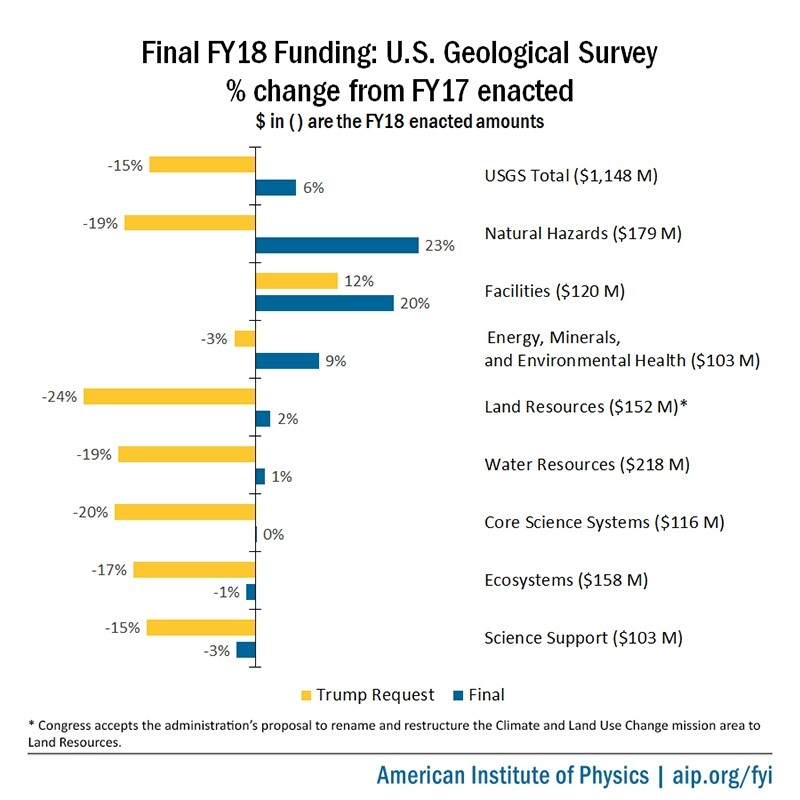
Final FY18 Appropriations: US Geological Survey
The final appropriations law for fiscal year 2018 provides the U.S. Geological Survey with a $63 million, or 6 percent, funding increase over the fiscal year 2017 enacted level to $1.1 billion.
Much of the increase is dedicated to the Natural Hazards mission area, including increased funding for the Earthquake Hazards Program to support the rollout of an earthquake early warning system and for the Volcano Hazards Program to support upgrades to volcano monitoring stations and instrumentation.
The Facilities account is also rising significantly, with the increase directed toward addressing the backlog of deferred maintenance and supporting the relocation of non-laboratory personnel from a facility in Menlo Park, California, to the nearby NASA Ames Research Center.
The joint House-Senate explanatory statement accompanying the legislation, which provides funding and policy direction to the agency, says the appropriation “includes additional, one-time funding for the purchase of equipment, infrastructure related projects, and deferred maintenance that should not be considered programmatic increases.”

The text of the final appropriations law is available here
Land Resources
Restructure maintains funding for climate research. While Congress accepts the Trump administration’s proposed restructuring of the Climate and Land Use Change mission area into a new “Land Resources” mission area, it does not agree to implement the significant cuts proposed to climate research and monitoring programs as part of the restructure. Instead, the statement directs that “work previously funded in the fiscal year 2017 structure will continue at fiscal year 2017 enacted levels.”
Climate Science Centers protected. The statement rejects the proposed elimination of four of the eight regional Climate Science Centers, which are now called Climate Adaptation Science Centers under the new budget structure. It instead maintains the overall budget at $25 million for the centers and says that “grant awards should be made at the negotiated annual agreement levels.”
Landsat-9 on track. The statement specifies $93 million for the National Land Imaging program. Within that amount, the Landsat-9 ground systems development program is fully funded at $26 million, keeping it on track for a scheduled launch date in 2020. NASA is responsible for Landsat-9 satellite procurement and launch, while USGS is responsible for the ground systems and operations.
Natural Hazards
Earthquake early warning system set for rollout. The budget for the Earthquake Hazards Program is rising 23 percent to $83 million. The statement specifies $13 million, a $2.7 million increase over the amount specified last year, to support continued development and a limited public release of ShakeAlert, an earthquake early warning system for the west coast of the U.S. It also provides an additional $10 million for the program to support capital costs associated with its buildout.
Seismic monitoring instruments slated for upgrades. The statement specifies $5 million for equipment upgrades at the National Earthquake Center and seismic stations that comprise the Advanced National Seismic System (ANSS), which monitors national earthquake activity.
The statement also specifies $1.4 million for the acquisition of seismic monitoring stations that are currently deployed in Alaska as part of the National Science Foundation’s EarthScope USArray project. Senate Energy and Natural Resources Committee Chair Lisa Murkowski (R-AK) voiced strong support for USGS acquiring these stations in a recent hearing
Further, the statement notes that “the Committees understand the adoption of the seismic and geodetic stations currently deployed as part of the USArray project, along with the ANSS investments in seismic monitoring, could contribute to a monitoring network similar to the earthquake early warning system [ShakeAlert] currently under development for the west coast and encourage the Survey to consider this effort once the west coast system is close to completion.”
Volcano early warning system protected. Funding for the Volcano Hazards Program is rising by 34 percent to $43 million. Congress rejected the administration’s proposal to suspend implementation of the National Volcano Early Warning System, and instead is providing $1 million for next-generation lahar detection systems and an additional $1.5 million for new lahar detection instrumentation and equipment.
The statement also specifies $13 million to upgrade outdated instrumentation that is not in compliance with the National Telecommunications and Information Administration’s radio spectrum guidelines.
Landslide risk report requested. Citing concern about landslide risk to local communities, the statement directs USGS to submit a report to Congress that identifies areas in the U.S. that are at the highest risk of landslide activity.
Energy and Mineral Resources
Funding for the Energy and Mineral Resources account in the Energy, Minerals, and Environmental Health mission area is increasing 10 percent to $80 million. The statement includes $1.5 million for geologic research and assessments related to carbon sequestration which was transferred to the program as part of the Land Resources mission area restructure. It also directs USGS to maintain current funding for geophysical and remote sensing activities supporting research at the enacted funding level.
Facilities
Menlo Park Facility in transition. The statement includes the requested $12 million increase to cover increased rent costs at the agency’s facility in Menlo Park, California, as well as support for the relocation of 200 non-laboratory personnel to the NASA Ames Research Center in Mountain View. USGS has not yet determined whether it will move remaining personnel and laboratories to the new facility.
Doubling for deferred maintenance. The statement specifies $15 million for deferred maintenance and capital improvement initiatives, double the amount requested by the administration. USGS said in its budget request that it has a $95 million backlog in deferred maintenance needs for its facilities and research vessels.


